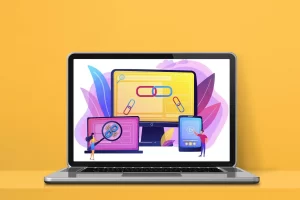We are all aware that technology, including the internet, constantly evolves.
The internet as we know it today is hardly recognisable from what it was ten years ago due to the yearly software developments, inventions, and optimisations. Similarly, the internet will likely undergo many changes in the years to come.
The most significant anticipated change to how we utilise the internet is Web 3. We’ll walk you through the definition of Web3 in this guide. We’ll also look at what you might expect from the internet in this new era, particularly about search engine optimisation (SEO) technology.
What Is the Type of Web We Have Now?
Saying that we are now using Web2 might be stating the obvious. But what exactly is Web2?
The World Wide Web version as it exists today is called Web2. It consists of centralised data hosting services dominated by social networking platforms like blogs, wikis, and wikis. These websites enable user interaction and the production of publicly available content.
The capacity to link people from all over the world and its user-friendly interface are two of Web2’s outstanding features. It is, therefore, the perfect forum for exchanging ideas and information. Web2 is remarkably adaptable because it also lets users build their own content.
There are many well-known Web2 applications available right now, including Facebook, Twitter, and YouTube. These websites have entirely transformed the way people communicate and share information. With millions of users worldwide, they have emerged as the most well-liked method of staying in touch with friends and family.
The impact of Web2 on businesses is equally significant. Many businesses use social networking services to communicate with clients and advertise their products and services. Additionally, many companies are using Web2 applications to build more interactive, user-friendly websites.
What Is Web 3.0?
The third generation of the World Wide Web is known as Web3. Users can engage with applications and services directly through this decentralised platform, eliminating the need for intermediaries. Web3 offers excellent security and direct ownership access thanks to its use of blockchain technology.
While user-generated content powers the internet in Web 2.0, those who produce it have no authority or influence. Web 3.0 aims to remove the “gatekeepers,” or those who are now in charge, such as major tech firms, search engines, and social media platforms, while granting users equal access.
Trust and ownership are prioritised in Web3, enabling:
- Open access to stored data
- Access to content with no permissions required
- Peer-to-peer connectivity
Blockchain technology is the component of Web3 search that will cause the most transformation. The goal is to give users a safe, decentralised, and unchangeable environment to communicate with each other and use applications.
Although Web3 is still in its early stages, it has the potential to alter how we use the internet entirely. With Web3, we look forward to the internet developing into a more inclusive, secure, and open network.
What Are the Potential Benefits of Web3?
Security, decentralisation, and accessibility are the three major benefits Web 3 is expected to offer the Internet.
Web3 is more secure than conventional centralised systems since all data is stored on a decentralised network of computers.
Decentralisation makes the network more resistant to censorship and hacking because no single entity is in charge. Additionally, intermediaries are not required to control who may use applications and services.
What Are the Potential Issues of Web3?
Of course, every new technology has downsides, potential risks, and future-related concerns. The introduction of Web 3 could run into some problems. Scalability, interoperability, and usability are a few of these.
A significant challenge for Web3 is the current scalability of blockchain technology. If the network is to be utilised by a large number of users, it must be able to manage high amounts of transactions.
Interoperability across several blockchains is another issue facing Web3. For the platform to be successful, different blockchains must be able to connect with one another, but there are currently no methods to facilitate this communication.
All of these issues will affect Web 3’s overall usability. Time will tell how well these adjustments are handled. Having said that, it is always advisable to prepare for the unforeseen.
What Does Web 3.0 Mean in SEO?
Keywords, backlinks, and content are the main building blocks of the current SEO paradigm. In the past, search engine optimisation has mostly concentrated on improving website content and code for increased visibility in search engine results pages.
However, these characteristics will start to change as Web3, or the decentralised web gains popularity.
In Web 3, SEO will witness a significant shift in emphasis, primarily towards user experience. In order to score highly in search results, websites will need to focus more on elements like design, navigation, and overall user experience.
Additionally, social media and other user-generated content will play a more significant part in SEO due to the greater emphasis on UX in this new era.
How Will Web 3.0 Impact SEO?
Some people think Web3 will be remembered as the official cause of SEO’s demise, but this is unlikely. NFTs, metaverses, and the cryptocurrency mania garner the most online attention. However, they are not web3’s primary components. These are just a few applications of blockchain technology.
The internet will always be a place where information reigns supreme. SEO will continue to exist as long as search engines exist and consumers need information online.
The most likely scenario is that SEO will adopt a new persona, like a superhero with a new costume. Businesses will look for strategies to appear in the results as people continue to utilise the internet for searching. Therefore, SEO best practices will change as online navigational tools do.
Voice Search: The Future of SEO
SEO best practices will place a greater emphasis on voice search content alignment in web3 regarding the future of SEO. It entails giving long-tail keywords priority. If someone wants to learn more about SEO on web 3.0, they may type something like “web 3 SEO” into the search bar, for instance. User intent is frequently more specific when using voice search; for example, you’d be more likely to say, “Okay, Google, tell me how SEO will work with web 3.” An incredibly personalised web experience will be possible because of this fine-tuning around search intent.
How to Adapt the Changes in Web 3 SEO Process?
We prefer to view Web 3 as an opportunity for development and innovation rather than a threat. Our knowledgeable SEO specialists have discovered several feasible options for securely adjusting to these modifications.
Focusing on the creation of rich media content that Web3 technologies can use is one approach. This can entail producing videos, infographics, and other visual material that Web 3 platform users can readily share and interact with.
It is also required to provide more tailored and niche content for each Web 3 platform to maximise the chance of ranking.
Another strategy entails establishing relationships with significant thought leaders and influencers within Web3 communities. Identifying and focusing on influential podcasters, bloggers, and other content creators popular in Web 3 communities could be one way to do this.
Engaging with highly focused audiences will be simpler by establishing relationships with the people they are most likely to respond to. These people will be in a position to assist us in promoting a client’s website, increasing traffic and SEO ranking.
Finally, it will be crucial to provide powerful words, images, and experiences for our client’s websites in keeping with our research of semantic content ranking presented above and the newly discovered significance of UX. Every user interaction will be as seamless, simple, and compelling as possible.
The success of any SEO strategy in the Web 3 era will ultimately depend on staying up-to-date with the most recent developments in this ever-shifting environment. Flexibility and willingness to try new things will be crucial to ensure that websites continue to rank highly on the new web.
Final Thoughts
Although the future of Web3 is uncertain, it has the power to alter how we use the internet completely. Web3 has the potential to provide a more open, accessible, and secure internet that works for everyone, despite issues with scalability, interoperability, and usability. The provision of safe, open, and accessible internet services for everyone will serve as the foundation for these developments.
The emergence of a Web 3 SEO process will most likely not eliminate SEO; it will just cause it to take on new shapes. Every industry is vulnerable to market whims and technology developments. Therefore you need industry specialists for SEO and web designs who are the best at predictin b gg how these changes will influence your business.
It pays to have the most recent, industry-leading expertise to guide you with a steady hand during any moment of significant change and uncertain times.
At TopRankings, we provide various digital marketing services, including but not limited to SEO. Our clients come to us from different sectors and degrees of expertise, ranging from small start-ups with limited marketing budgets to sizable, well-known companies with extensive commercial experience.
As a leading SEO agency, we pride ourselves on creating outstanding, measurable leads and sales growth. With us, great results are given. What sets our boutique SEO Agency apart is the honesty and integrity with which we work – values that underpin every element of our partnership with you.
Are you looking for an SEO Agency in Melbourne that people have trusted for over two decades? Sweat no more. Contact us now, and our friendly team members are happy to assist you!



